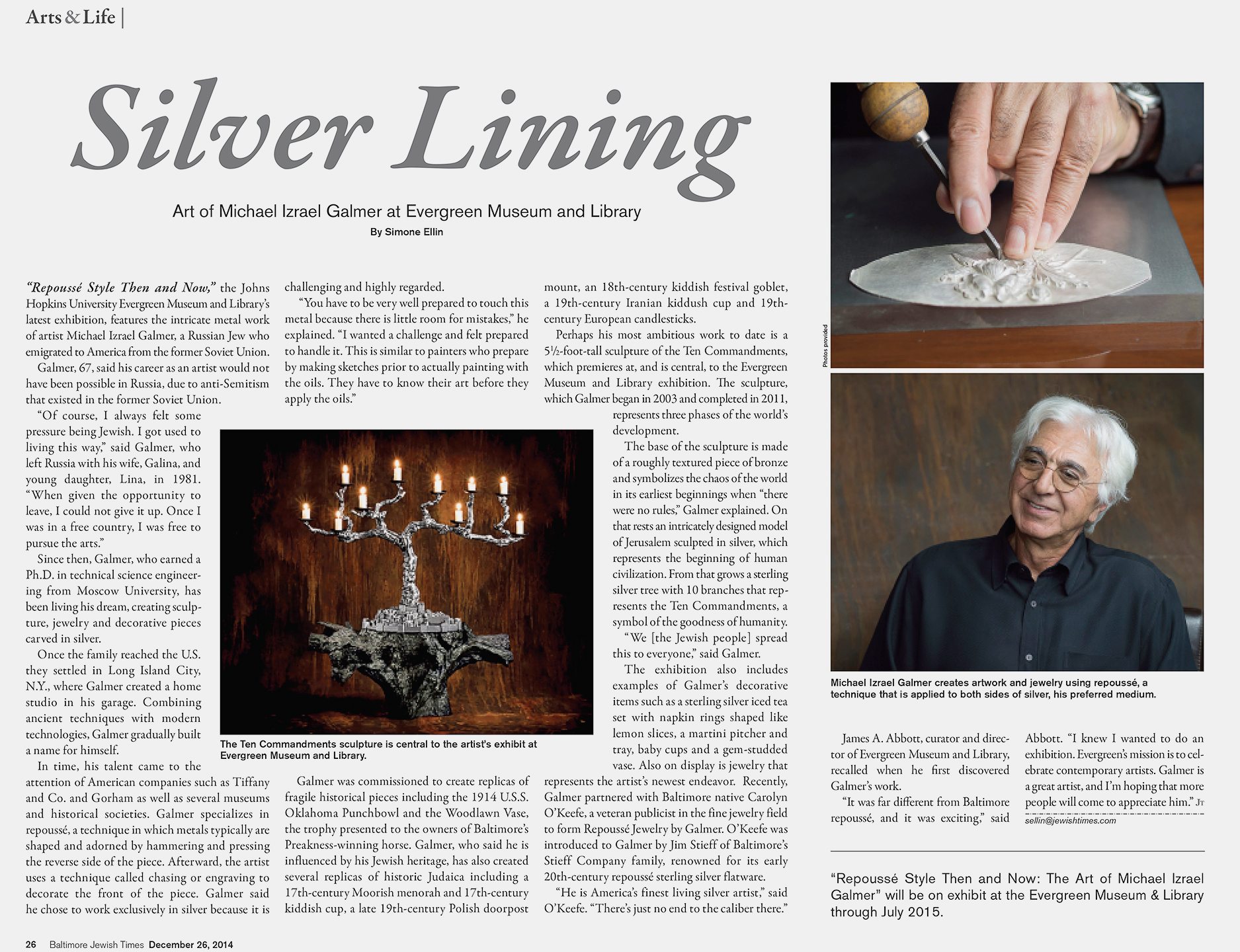The Ten Commandments
The story behind the Ten Commandments
Silver Lining: Art of Michael lzrael Galmer at Evergreen Museum and Library
"Repoussé Style Then and Now," the Johns Hopkins University Evergreen Museum and Library's latest exhibition, features the intricate metal work of artist Michael Izrael Galmer, a Russian Jew who emigrated to America from the former Soviet Union.
Galmer, 67, said his career as an artist would not have been possible in Russia, due to anti-Semitism that existed in the former Soviet Union.
"Of course, I always felt some pressure being Jewish. I got used to living this way," said Galmer, who left Russia with his wife, Galina, and young daughter, Zina, in 1981. "When given the opportunity to leave, I could not give it up. Once I was in a free country, I was free to pursue the arts.”
Since then, Galmer, who earned a Ph.D. in technical science engineering from Moscow University, has been living his dream, creating sculpture, jewelry and decorative pieces carved in silver.
Once the family reached the US. they settled in Long Island City, N.Y., where Galmer created a home studio in his garage. Combining ancient techniques with modern technologies, Galmer gradually built a name for himself.
In time, his talent came to the attention of American companies such as Tiffany and Co. and Gorham as well as several museums and historical societies. Galmer specializes in repoussé, a technique in which metals typically are shaped and adorned by hammering and pressing the reverse side of the piece. Afterward, the artist uses a technique called chasing or engraving to decorate the front of the piece. Galmer said he chose to work exclusively in silver because it is challenging and highly regarded.
"You have to be very well prepared to touch this metal because there is little room for mistakes," he explained. "I wanted a challenge and felt prepared to handle it. This is similar to painters who prepare by making sketches prior to actually painting with the oils. They have to know their art before they apply the oils."
Galmer was commissioned to create replicas of fragile historical pieces including the 1914 U.S.S. Oklahoma Punchbowl and the Woodlawn Vase, the trophy presented to the owners of Baltimore's Preakness-winning horse. Calmer, who said he is influenced by his Jewish heritage, has also created several replicas of historic Judaica including a 17th-century Moorish menorah and 17th-century kiddish cup, a late 19th-century Polish doorpost mount, an 18th-century kiddish festival goblet, a 19th-century Iranian kiddush cup and 19th-century European candlesticks.
Perhaps his most ambitious work to date is a 5 1/2-foot-tall sculpture of the Ten Commandments, which premieres at, and is central, to the Evergreen Museum and Library exhibition. The sculpture, which Galmer began in 2003 and completed in 2011, represents three phases of the world's development.
The base of the sculpture is made of a roughly textured piece of bronze and symbolizes the chaos of the world in its earliest beginnings when "there were no rules” Galmer explained. On that rests an intricately designed model of Jerusalem sculpted in silver, which represents the beginning of human civilization. From that grows a sterling silver tree with 10 branches that represents the Ten Commandments, a symbol of the goodness of humanity.
"We [the Jewish people] spread this to everyone” said Galmer.
The exhibition also includes examples of Galmer's decorative items such as a sterling silver iced tea set with napkin rings shaped like lemon slices, a martini pitcher and tray, baby cups and a gem-studded vase. Also on display is jewelry that represents the artist's newest endeavor. Recently, Galmer partnered with Baltimore native Carolyn O'Keefe, a veteran publicist in the fine jewelry field to form Repoussé Jewelry by Galmer. O'Keefe was introduced to Galmer by Jim Stieff of Baltimore's Stieff Company family, renowned for its early 20th-century repoussé sterling silver flatware.
"He is America's finest living silver artist,' said O'Keefe. "There's just no end to the caliber there."
James A. Abbott, curator and director recalled when he first discovered Galmer's work.
"It was far different from Baltimore repoussé , and it was exciting,” said Abbott. "I knew I wanted to do an exhibition. Evergreen's mission is to celebrate contemporary artists. Galmer is a great artist, and I'm hoping that more people will come to appreciate him.”
A Smith Comes From Russia
As a young man in Moscow, Mikhael Izrael was interested in art and sculpture, but he became a scientist, earning a doctorate in physics and chemistry.
"You could not make a living as an artist”, he says. "It was a hobby.”
As an immigrant here, three decades ago, he changed his name to Michael and decided to follow his dream.
He taught himself to become a silversmith, and has made his living at that ever since. “My family supported me,” he says.
Working out of a studio in Long Island City, Queens, he fashions creations that range from menorahs, inset, and visions of Jerusalem, below, to punch bowls for battleships and awards trophies for the Preakness thoroughbred race.
Izrael’s firm is named Galmer Silversmiths, the name a rough combination of Galena, his wife, and of Michael.
He works with "only silver, and a little bit bronze,” he says. "I love the metal.”
![Sterling silver and bronze 'Ten Commandments' sculpture by Michael Galmer. Photography by [ZeO] Productions.](../img/sculptures/GALMER-Ten-Commandments.jpg)

